
NPS/J. Jurado 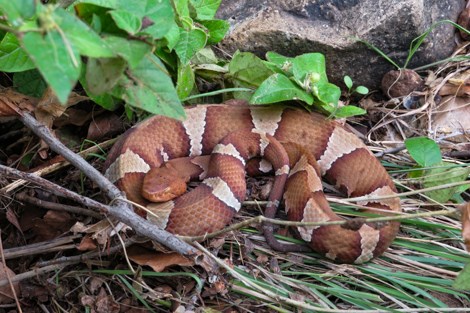
NPS/J. Jurado Trans-Pecos CopperheadAgkistrodon contortrix pictagasterThe Trans-Pecos copperhead is a venomous snake, found throughout the park in the proper habitat, which includes springs and the Rio Grande. This subspecies is confined to far West Texas and northeastern Mexico. Newborn copperheads are capable of finding and capturing their own prey at the time of birth. They have a maximum lifespan in the wild of 15-18 years. If threatened, copperheads may vibrate the tip of their tail to mimic a rattlesnake, and will strike if sufficiently threatened. Kingsnakes are reported to be immune to their venom. 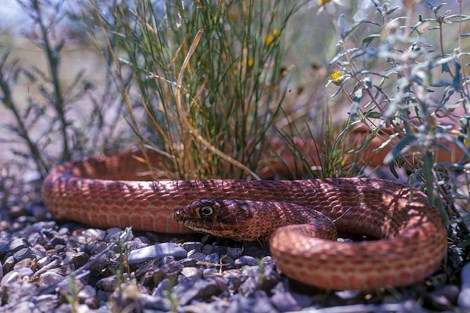
NPS Photo Western CoachwhipMasticophis flagellum testaceusPreferring desert lowland and scrub lands, the western coachwhip is found from the Rio Grande floodplain to the Chisos Mountains foothills. They are swift and will climb trees and shrubs. One of the fastest snakes in North America, with the ability to turn quickly, coachwhips have few natural predators. When a coachwhip snake bites, they thrash their head from side to side, tearing the skin after puncturing it. Western coachwhips remain active during the middle of the day, which makes them the snake most often seen in the park. 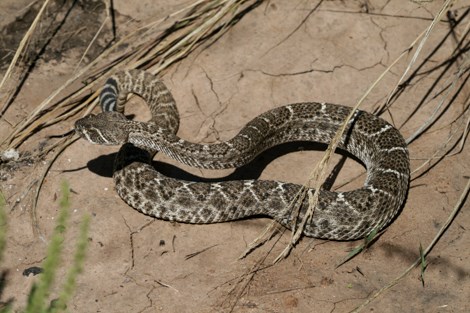
NPS/CA Hoyt Western Diamondback RattlesnakeCrotalus atroxThis venomous rattlesnake is found in the park from the Rio Grande floodplain up to the foothills of the Chisos Mountains (up to about 4,500 feet). They have a plump body, short tail, and a broad triangular head. Rattlesnakes are good at controlling rodent problems, and will also eat small mammals, birds, fish, and even invertebrates. Western diamondback rattlesnakes are aggressive and easily excitable, and cause more fatalities than any other snake in the United States. 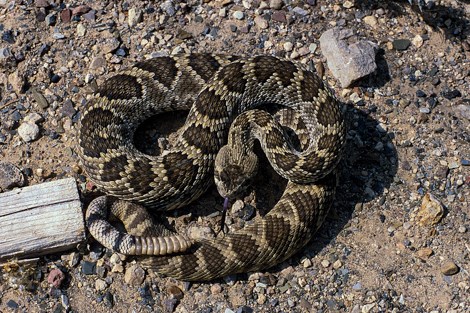
NPS Photo Mojave RattlesnakeCrotalus scutulatus scutulatusThese venomous rattlesnakes are found throughout the park from the Rio Grande floodplain up to about 4,000 feet. Mojave rattlesnakes occupy low, hot deserts, creosote bush flats and grasslands. They are very similar in appearance to western diamondback rattlesnakes, the key difference is in the bands on the tail. Western diamondback rattlesnakes have alternating similiarly-sized bands of black and white, while the Mojave's tail is mostly white with thin black bands. 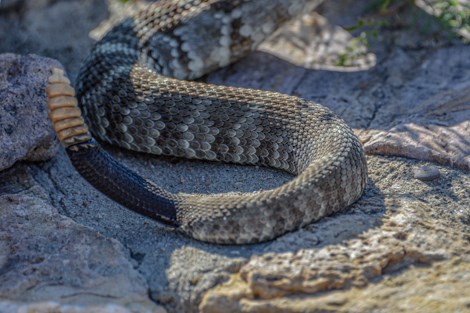
NPS/C. Ballou Black-tailed RattlesnakeCrotalus molossus molossusThe black-tailed rattlesnake prefers mountains, canyons, and rock outcrops. They are found park-wide, but are most common in the Chisos Mountains and foothills. This species can climb trees and are also able to swim quickly in water. They communicate threats to their enemies by using three devices. First, they will rattle their tail to startle an aggressor. If this doesn't work, they will then hiss loudly and rapidly flick their tongue, in addition to rattling. Another warning typical of vipers is to puff up and coil their bodies, making them look much larger. 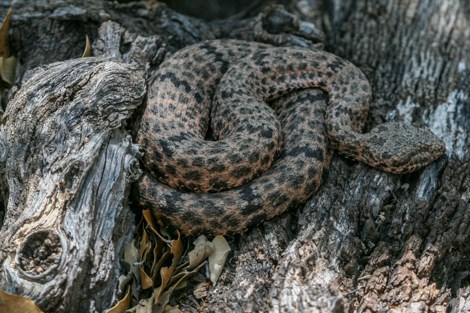
NPS/CA Hoyt Mottled Rock RattlesnakeCrotalus lepidus lepidusThis venomous snake is found throughout the park, but most commonly in the Chisos Mountains and foothills. They spend most of their lives in rocky outcroppings and talus slopes. Mottled rock rattlesnakes are small compared to other rattlesnakes, rarely exceeding 3 feet in length, but they have a fairly thick body for their size. In general, these rattlesnakes are not aggressive. They tend to rely on their camouflage and will often not strike or even rattle their tails unless physically harassed. 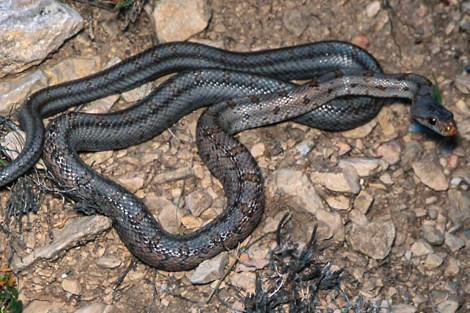
NPS Photo Baird's Rat SnakePantherophis bairdiIn North America, this snake is found only in portions of central and west Texas, and northern Mexico. Preferring forested uplands, rocky wooded canyons, upland meadows, and shrublands, the Baird's rat snake lives in the Chisos Mountains above 4,000 feet. This rat snake is slow-moving and generally calm, but will hiss and may strike if threatened. It feeds on small mammals, birds and lizards. 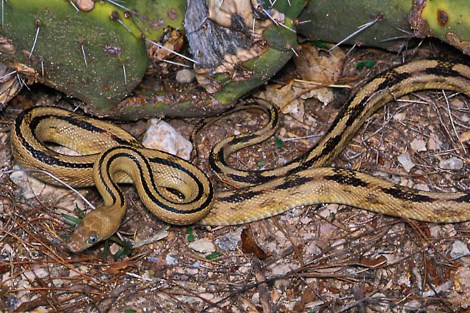
NPS Photo Trans-Pecos Rat SnakeBogertophis subocularis subocularisThis rat snake is a Chihuahuan desert endemic, being found exclusively in New Mexico, the Trans-Pecos region of West Texas, and the state of Chihuahua in Mexico. Within the park, they inhabit the Rio Grande floodplain up to the Chisos Mountains foothills below 5,000 feet. They are non-venomous, instead killing their prey by constriction. Only in rare instances will they defend themselves from humans by biting. Trans-Pecos ratsnakes are usually seen at night crossing roads during the hot months of summer. They retreat to limestone cracks and crevices during the day. 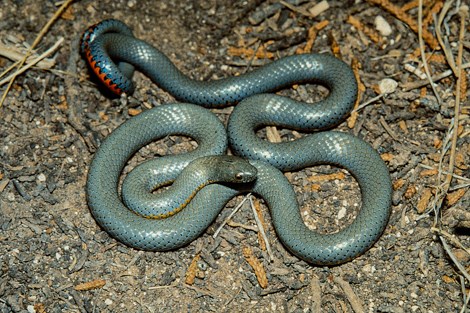
NPS Photo Regal Ring-necked SnakeDiadophis punctatus regalisThis secretive snake inhabits rocky moist areas - under rocks, logs, sotols, and agaves. Within the park it is found mainly in the Chisos Mountains and foothills, rarely seen in other mountains and canyon lowlands along the Rio Grande. When disturbed, it will coil its tail like a corkscrew, exposing the underside which is usually bright red. Small snakes and lizards are probably the most important food sources for this subspecies. Worms, slugs, and insects are also eaten by this species. Its mild venom may help to incapacitate prey, including juvenile California king snakes. 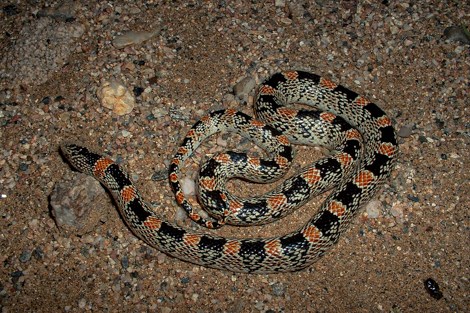
NPS Photo Texas Long-Nosed SnakeRhinocheilus lecontei tessellatusWithin the park, these snakes are found from the Rio Grande floodplain to the Chisos Mountains and north to the Rosillos Mountains. They prefer desert, creosote and bush flats and can be found resting during the day under rocks, sotol, or in animal burrows. They are active at night, particularly after it rains. The color pattern of the nonvenomous Texas long-nosed snake is vaguely similar to that of a venomous coral snake. In some western localities, the red coloration can be greatly reduced, giving it more of a black and white banded appearance. 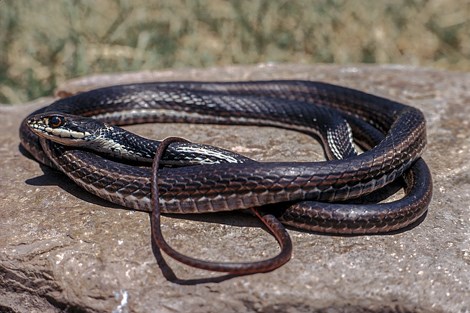
NPS Photo Central Texas WhipsnakeMasticophis taeniatus girardiThe Central Texas whipsnake is found park-wide except for possibly the highest parts of the Chisos Mountains. Holding its head several inches above the ground to survey its surroundings, the whipsnake glides slowly over the ground, watching intently for prey to dart across its path. This active forager does not restrict its diet to any particular group of animals. It will eat birds and their eggs, lizards, other snakes, and small mammals - even bats! Equipped with a slender, light-weight body, this snake is a proficient climber and can sometimes be found up in trees and bushes, searching for avian prey. 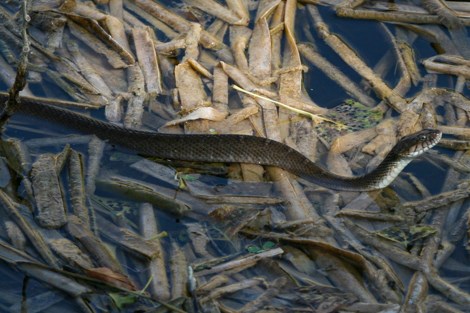
NPS/CA Hoyt Blotched Water SnakeNerodia erythrogaster transversaThese snakes are semi-aquatic, using both terrestrial and feshwater habitats. Within the park, they are only found along the Rio Grande between Hot Springs and Boquillas Canyon, including the beaver pond at Rio Grande Village. Feeding primarily occurs in or near ephemeral ponds or pools where frogs and toads are abundant. Snakes in this genus will flatten themselves or flee when detected. If cornered, they will strike fiercely. They are known to discharge an odorous musk in self-defense. 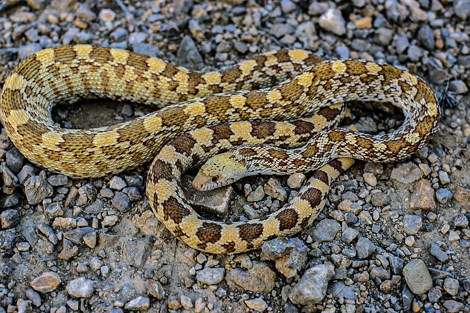
NPS Photo Sonoran Gopher SnakePituophis catenifer affinisThe Sonoran gopher snake is found park-wide in desert, shrub lands, and woodland habitats. It is known to sometimes climb trees. When threatened, it can hiss, inflate its body, flatten the head, and shake its tail rapidly, which may sound like a rattle if done in dry leaves. This snake has tough skin on its nose to assist with burrowing into gopher holes. It feeds on small mammals, including gophers; and will eat some birds, as well as lizards. It is a constrictor that kills prey by suffocating them in body coils. |
Last updated: June 25, 2023
